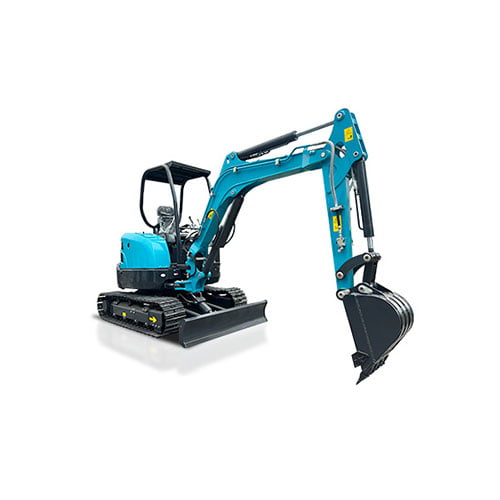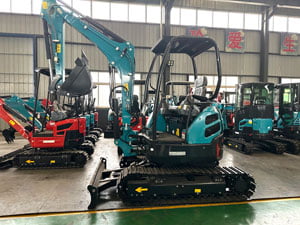Introducción
-1.jpg)
En la industria de la construcción actual, la miniexcavadora de 1,7 t desempeña un papel fundamental por su tamaño compacto y su versatilidad. Sin embargo, su utilidad va acompañada de importantes consideraciones medioambientales. Este blog profundiza en el impacto medioambiental de estas máquinas, centrándose en las emisiones, la eficiencia del combustible, la contaminación acústica y el análisis del ciclo de vida. Comprender estos aspectos es crucial para tomar decisiones informadas sobre la elección de equipos de construcción que se ajusten a los objetivos de sostenibilidad.
Emissions Profile
Emission Types
Mini excavators, including the 1.7t models, emit pollutants during operation. These emissions primarily include nitrogen oxides (NOx), particulate matter (PM), carbon monoxide (CO), and hydrocarbons (HC). The combustion engines in these machines are the primary source of these pollutants, contributing to urban air quality challenges, especially in densely populated areas.
Comparative Emissions
To contextualize the environmental impact, it’s essential to compare the emissions of 1.7t mini excavators with larger construction equipment and alternative technologies. Table illustrates a comparative emissions analysis, highlighting the differences in emissions between a 1.7t mini excavator and larger excavators commonly used on construction sites.
| Equipment | NOx emissions (g/h) | PM emissions (g/h) | CO emissions (g/h) | HC emissions (g/h) |
|---|---|---|---|---|
| 1.7t Mini Excavator | 8.5 | 0.4 | 3.2 | 1.5 |
| Excavadora más grande | 15.2 | 0.8 | 5.7 | 2.8 |
| Electric Excavator | 0 | 0 | 0 | 0 |
Fuel Efficiency and Consumption
Fuel Consumption Rates
Fuel efficiency is critical for assessing the environmental impact of mini excavators. The 1.7t models typically consume diesel fuel, and their efficiency varies depending on factors such as load capacity and operational intensity. Understanding these consumption rates helps in optimizing usage to minimize environmental impact.
Technologies for Fuel Efficiency
Advancements in engine technology and the adoption of alternative fuels (e.g., biodiesel) contribute to reducing fuel consumption and emissions. Table outlines the fuel consumption rates of a 1.7t mini excavator compared to alternative fuel types and technologies.
| Equipment | Fuel Consumption (liters/h) | CO2 Emissions (g/kWh) | Fuel Type |
|---|---|---|---|
| 1.7t Mini Excavator | 6.5 | 220 | Diesel |
| Electric Mini Excavator | N/A | 0 | Electricity |
| Biodiesel-Powered | 5.8 | 200 | Biodiesel |
Contaminación acústica
Noise Levels
Mini excavators emit noise during operation, affecting both workers’ health on-site and the surrounding environment. Noise levels are measured in decibels (dB) and vary depending on the type of operation and distance from the source. Managing these noise levels is crucial for complying with noise regulations and promoting a safer work environment.
Noise Reduction Measures
Incorporating noise reduction technologies such as sound-insulated cabins, quieter hydraulic systems, and implementing operational schedules that minimize noisy tasks during sensitive hours can significantly mitigate noise pollution. Table provides an overview of noise levels generated by a 1.7t mini excavator compared to regulatory limits.
| Equipment | Noise Levels (dB) | Regulatory Limit (dB) |
|---|---|---|
| 1.7t Mini Excavator | 80 | 85 |
| Electric Mini Excavator | 70 | 85 |
Lifecycle Analysis
Evaluación del impacto ambiental
A lifecycle analysis evaluates the environmental impact of mini excavators from cradle to grave. This analysis considers factors such as raw material extraction, manufacturing processes, transportation, operation, and end-of-life disposal. Each stage contributes to the machine’s overall environmental footprint.
Sustainable Manufacturing Practices
Adopting sustainable manufacturing practices, such as using recycled materials, reducing energy consumption during production, and optimizing logistics, can minimize the environmental impact of mini excavators. Table 4 outlines the lifecycle stages and associated environmental impacts of a 1.7t mini excavator.
| Lifecycle Stage | Impacto medioambiental |
|---|---|
| Raw Material Extraction | High energy consumption, resource depletion |
| Manufacturing | Emissions, waste generation |
| Transportation | Carbon footprint |
| Operation | Emissions, fuel consumption |
| End-of-Life Disposal | Waste generation, recycling potential |
Alternative Technologies
Electric Mini Excavators
.jpg)
Electric-powered mini excavators offer a promising alternative to traditional diesel-powered models. They produce zero tailpipe emissions, significantly reduce noise pollution, and potentially lower operational costs over their lifecycle. However, challenges such as limited battery life and higher initial costs need addressing for broader adoption in the construction industry.
Advantages and Challenges
The advantages of electric mini excavators include environmental benefits, reduced operational noise, and potential cost savings over time. Yet, challenges like infrastructure for charging and range limitations must be overcome for widespread adoption.
Conclusión
The environmental impact of using a 1.7t mini excavator on construction sites encompasses emissions, fuel consumption, noise pollution, and lifecycle considerations. While these machines are indispensable for construction activities, their environmental footprint can be minimized through technological advancements, fuel efficiency improvements, and sustainable practices. Moving forward, integrating alternative technologies like electric-powered excavators and adhering to stringent environmental standards will be pivotal for promoting sustainability in construction operations.
PREGUNTAS FRECUENTES
Q:What are the main environmental concerns associated with 1.7t mini excavators?
A:The primary concerns include emissions of pollutants (NOx, PM, CO, HC), fuel consumption rates, noise pollution, and the overall lifecycle impact.
Q:How do electric mini excavators compare to diesel-powered ones?
A:Electric mini excavators offer advantages such as zero tailpipe emissions, reduced noise levels, and potentially lower operational costs over their lifecycle. However, challenges such as limited battery life and higher initial costs need addressing for wider adoption.
Q:What measures can be taken to mitigate the environmental impact of miniexcavadoras?
A:Implementing technologies for fuel efficiency, adopting alternative fuels, reducing noise levels through insulation and scheduling, and promoting sustainable manufacturing practices are effective measures.




